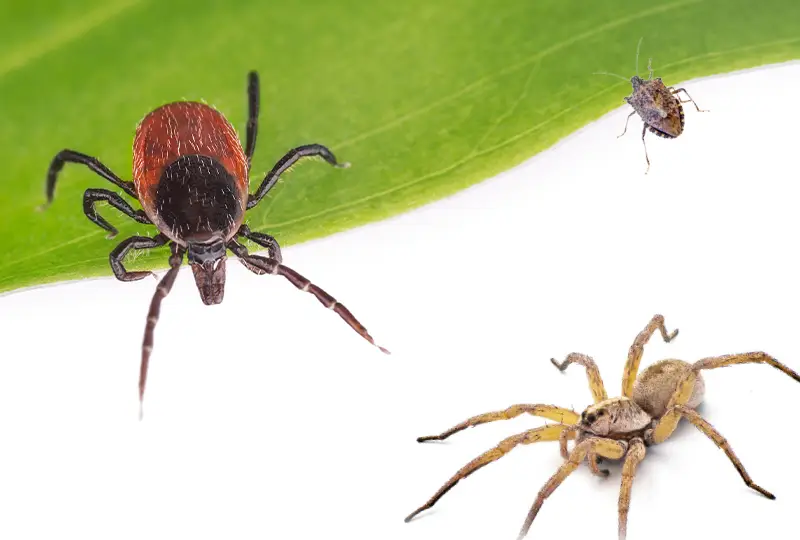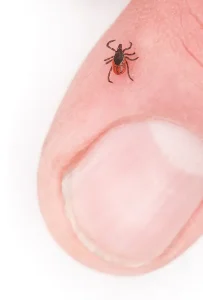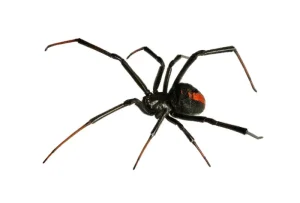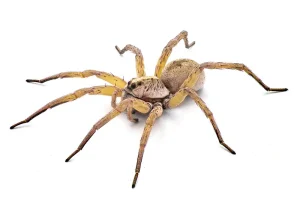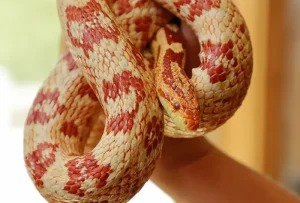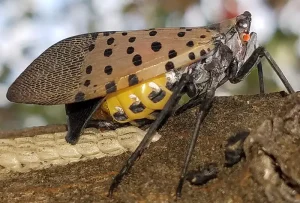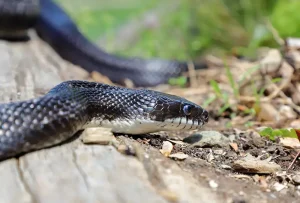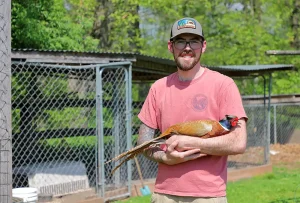Find Out How To Respect and Coexist with Creatures In Nature
by Lois Szymanski
‘Tis the Season for the Great Outdoors
Ways of Staying Safe Outdoors This Summer
If you’ve listened to birds singing in rustling branches overhead or gazed at a rainbow in a sun-streaked sky, you know that exploring nature is good for your mental health. Carroll County summers provide plenty of opportunity to enjoy outdoor spaces, but before stretching out on a grassy knoll or strolling through the forest, be aware of all that awaits you in the great outdoors.
Jenna Mele, park naturalist at Bear Branch Nature Center in Westminster, says there’s not much to worry about in Carroll County, but she has a lot to share about the spiders, bugs and snakes we could find on our journey. “There are 27 species and subspecies of snakes in Maryland,” she said.
“There are hundreds of species of spiders and millions of insects, worms, arachnids and bugs. While most people are worried about spiders, the main ones people should be aware of are ticks.”
People encounter ticks in shady forests, lush grasses, undergrowth, shrubs, bushes, hedges and wetlands. Mele said deer ticks are the worst because they carry Lyme disease, but other species of ticks can infect humans with other diseases. She advises never skipping a total body tick check after coming in from outdoors.
“Always be sure to do a tick check on yourself after coming back from a hike,” she says. “Especially pay attention to crevices such as behind the ears, around the armpits and groin areas, and anywhere your clothes cinch your skin, like socks and pants.”
Before stepping out into nature, Mele recommends prevention, especially from ticks and mosquitoes, as they can carry diseases.
“There are many insecticides, such as Permethrin, you can treat your clothing with before hiking,” she advises. “Also, the sooner you can locate and safely remove a tick, the less likely one is to become infected with any tick-borne illness it may be carrying.”
According to Mele, snakes and spiders in our area offer little threat.
“Common spiders in Carroll County include wolf spiders, orb weavers, jumping spiders, cellar spiders and crab spiders,” she shared. “The only medically significant spider species native to the state is the black widow. While brown recluse spiders are venomous and cause significant damage when they bite, they are not native to Maryland and cannot survive our climate.”
Mele says black widows look nothing like other Maryland spider species, making them easy to identify. The red hourglass on their abdomen stands out. They mainly reside in rock or lumber piles, around unused gardening equipment or near small outbuildings, such as tool shops or woodsheds.
“They also make a very irregular web, so if you see a spider in a nice pretty web, it’s not a black widow,” she says.
Ryan Bridge from nearby York, Pennsylvania, is known as The BugMan. A certified entomologist with years of experience, he’s been using live insects and other arthropods to teach entomology since 1995. On June 27, he’ll provide educational programs at the Taneytown branch of the Carroll County Public Library at 10:30 a.m. and the Finksburg branch library at 1 p.m. He hopes attendees will discover that they no longer need to fear insects, spiders or bugs.
“Realistically, we don’t have to be afraid of bugs or insects,” he says. “While we do have black widows, it is unlikely that you will be bitten by one. Maryland is loaded with black widows, but they are seldom seen, which is proof that they are not as dangerous as we think.”
Bridge admitted the black widow is probably the only spider we should be aware of but not fear as a species.
“Most people react with fear when they see a spider when their reaction should be appreciation,” he says. “Insects and bugs are the most important components in our ecosystem. Everything relies on them in one shape or another — fish, animals and people. A bug or insect is involved in every part of life. Bugs and insects are required for us to exist.”
Bridge says bad things happen only when people disrespect nature. He added that he tries to coach parents to stop saying, “That bug might bite you,” because children will spend a lifetime thinking bugs will bite them.
“People think bugs are out to get them, but that is not true,” he shares. “Bugs and insects do not think about hurting people. They don’t think about people at all. They may react if we make ourselves a threat, but they will try to run away first. We need bugs and insects, and most of all, we need spiders. Spiders are the No. 1 consumers of mosquitoes.”
Mele echoed Bridge’s words but included snakes in the do-not-fear category. She shared some common snakes found in Carroll County, including eastern rat snakes, garter snakes, ringneck snakes, common water snakes and milk snakes. But Mele said Maryland only has two medically significant snake species, the eastern copperhead and the timber rattlesnake. Medically significant means hospitalization should result following a bite.
According to Mele, rattlesnakes are seldom seen east of Frederick County. Snake expert Garrett Martin of Taneytown agreed.
“Both the copperhead and the timber rattlesnake are extremely uncommon in our area,” he says. “Both are more likely to be found in Frederick County and west.” Martin advises folks to keep their distance.
“Snakes are not going to go out of their way to bite someone. They are just trying to survive,” he says. “They have predators as well, so they usually try to stay out of sight. Take a picture from a distance or at least 6 to 10 feet and keep moving.”
Morel mushroom hunters are more likely to encounter a copperhead, Martin says, because they can occupy the same type of habitat where these mushrooms grow.
“Hikers off-trail should look for large rocks or low-down logs,” Martin says. “Watch where you place your foot when walking. If you step on it [the snake], you run the risk of being bitten. Early in the morning when the sun is coming through the trees and heating a rock, they may lay on the rock to sun themselves.”
Mele says there are few sensory cues to alert a hiker to a dangerous snake.
“The whole thing about copperheads smelling like cucumbers is misleading,” she said. “They — along with many snake species — will musk when startled to dissuade predators. But generally, it doesn’t smell like melons or cucumbers to everyone. Of course, rattlesnakes usually rattle when disturbed.”
Other Maryland snakes with venom include ringneck and hognose snakes, but Mele said their bites cause only some itching or swelling at best.
If you’re bitten by a venomous spider or snake, Mele has some advice.
“Remain calm,” she says. “It keeps the venom from spreading faster through heightened blood flow. Ideally, if you or a person you are with can get a photo of what bit you for proper ID, that would be very helpful when the hospital goes to treat you. Then, get to a hospital as safely and quickly as possible.”
Mele recommended the Maryland Poison Center if needed. Poison Center staff answer phones 24 hours a day. Contact the center by calling 800-222-1222.
“Most bite outcomes are generally positive with recovery one to two days after a bite,” Mele says. “Do not tourniquet the area, apply ice or attempt to suck out the venom. These methods do not work and often cause more harm to the body.”
Mele fondly remembered a copperhead snake she had lunch with a few years back, even photographing it as it sunned on a rock next to her.
“I was lucky enough to sit down next to it and have lunch with it while monitoring my group of summer camp kids, so they didn’t accidentally sit on it,” she says. “We were visiting a part of the Appalachian Trail for summer camp a few years ago. We got up to a nice outcropping of rocks to have lunch with a view. One of the camp kids was about to sit down when she announced there was a snake. We made everyone back up immediately, and sure enough, it was a copperhead, but that snake could have cared less about us. It even wiggled its way to face the rocks instead of outwards as we sat next to it. I never felt unsafe, and it wasn’t threatened by our presence either.”
Mele says no snake or spider wakes up one morning and thinks, “Today’s the day. I’m going to bite as many people as I possibly can.” Instead, they wake up thinking, “It’s been about a week since I last ate a mouse [or mosquito]. I guess I should try to find one.”
“Animals are out to do the same thing we are, just trying to survive,” Mele says. “They are trying to find food, water, shelter and space, and then they may try to find a mate and have babies. Snakes and bugs are not evil killers bent on causing people distress. And most are hugely significant in the ecosystem. Without snakes and spiders, our rodent and bug populations would be out of control.”
Martin, Bridge and Mele all believe we should take time to enjoy nature and respect the right of every species to survive.
“Even venomous snakes have importance,” Mele says. “Copperhead venom is being used in breast cancer studies. Most people have walked near, over or past so many snakes and spiders in their life — and they didn’t even know it!”
With warmer temperatures finally here, you too can enjoy the great outdoors and appreciate what nature has to offer.
“Snakes are not going to go out of their way to bite someone. They are just trying to survive. They have predators as well, so they usually try to stay out of sight. Take a picture from a distance or at least 6 to 10 feet and keep moving.” – GARRETT MARTIN

